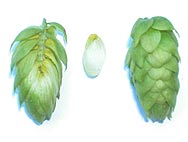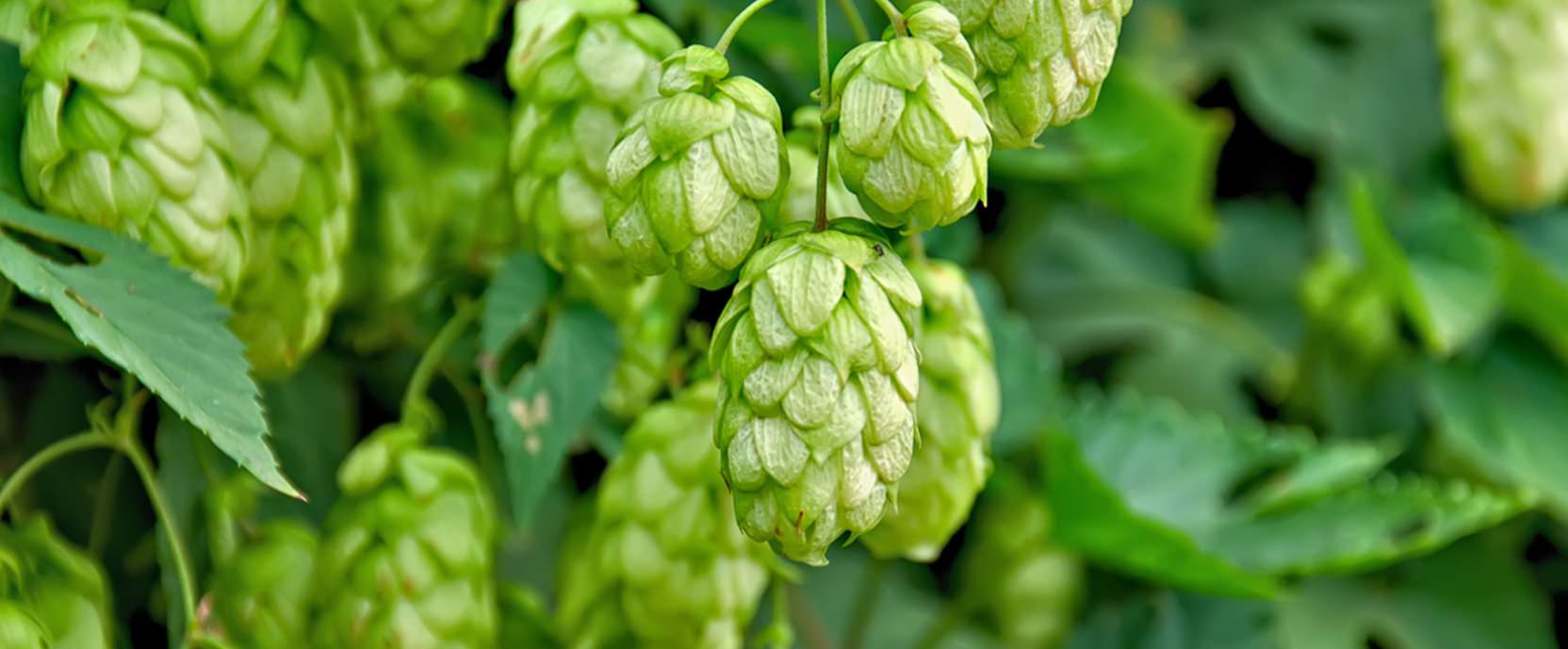
Humulus lupulus L.
Hops

History
The generic name Humulus, coined in the Middle Ages, is said to derive from the Slavic word chmele (hops) or from the old Germanic word Humel or Humela (fruit-bearing). Speculation that the name comes from the Latin word humus (earth) is unfounded. The species name lupulus is the diminutive of lupus (wolf), which refers to the mistaken idea that hop tendrils strangle plants. The origin of the English name hop is uncertain, but may originate from the Norwegian word hupp, which means ‘tassel’ or ’tuft‘ or from the Anglo-Saxon hoppan (to climb). The Hop was known in antiquity, but does not appear to have been used either as a medication or as an ingredient in producing beer. The 8th century Arab physician Mesuë recommended the syrup as a good medication for bilious fever and for purifying the blood. It subsequently appeared in herbal books during the Middle Ages. Lonicerus writes: “Water, mornings and evenings, each time drunk in three measures, and its drink mixed therewith, for three or four weeks, purifies the blood and relieves melancholy, tiredness, impetigo, mange, leprosy and all that comes of impure blood. The water, when drunk, eases congestion of the spleen, stabbing pains, and all illnesses arising from or caused by a congested spleen.” The physician Bohn wrote at the beginning of this century: “Hops have a strong diuretic effect and can be used to combat problems in the urinary system. Hops are considered a calming remedy.”

Botanical Characteristics
The Hop is a four to eight metres long perennial climbing plant that likes to twine up hedges, fences, and the edges of forests. In spring, thin, rough stalks with anchor-like, astonishingly adhesive hairs rise from the branched rootstock. In contrast to most European climbing plants, the hop twists in a clockwise direction. The heart-shaped, three- to five-lobed leaves are sharply dentate and opposing. The hop is dioecious, i.e. there are male and female plants. Male flowers form axillary, hanging panicles with whitish-green, five-tipped bracts. They do not develop lupulin glands and are therefore not cultivated. The female plants form cone-shaped catkins which form small, oval multiple fruits composed of yellowish-green scales. The interior surface of the scale bears small, yellowish-reddish glands that give the hop its characteristic bitter taste. The hop is pollinated by means of wind dispersal.The Hop flowers from July to August.

Habitat
The hop originated in eastern Europe and western Asia. It loves deep, nutrient-rich soils and sites protected from the wind at the edges of forests, fences, and hedges at altitudes up to 1000 - metres. In Europe, hops have been cultivated since the end of the Merovingian culture (3rd to 8th centuries), when beer replaced mead. Today, hops are cultivated on high poles or wires in large hop gardens in many countries with temperate climates.

Preparation
A.Vogel/Bioforce uses the alcohol extract from fresh hop catkins gathered in August from organic cultivation.Today, Hop catkins are mostly used in brewing beer. They give beer its characteristically bitter, full-flavoured, and aromatic taste. Hops also help keep beer from spoiling, since the bitter acids of the hops destroy Gram-positive (retaining a stain of methyl violet and iodine on treatment with alcohol) bacteria. Dried hop catkins are used to fill sleep-inducing pillows and are often an ingredient in tea mixtures. Care must be taken not to store hops for longer than a year or they lose their potency. Hop glands (lupulin) are also used medinically. In the past, Hops used to be eaten like asparagus.

A.Vogel Blog – Natural and Healthy
Inspiration for a healthy life!
HERBAMARE SOUP-ER SOUPS!
DOWNLOAD YOUR FREE RECIPE BOOKLET!
8 healthy, hearty and delicious homemade soups.
Supporting a healthier happier you
“Nature is just about the best thing we’ve got!“
Alfred Vogel's guide to leading a healthy and happy life
Healthy & nutritious dinner ideas
Get new recipes in your inbox every month. Sign up now